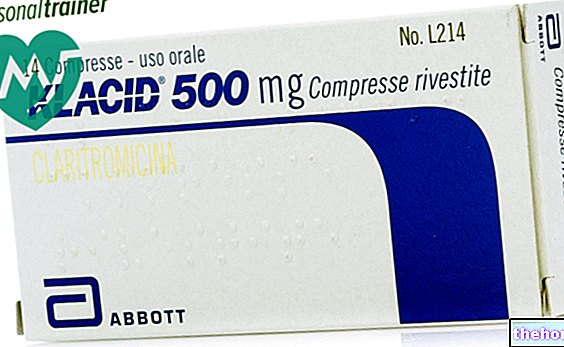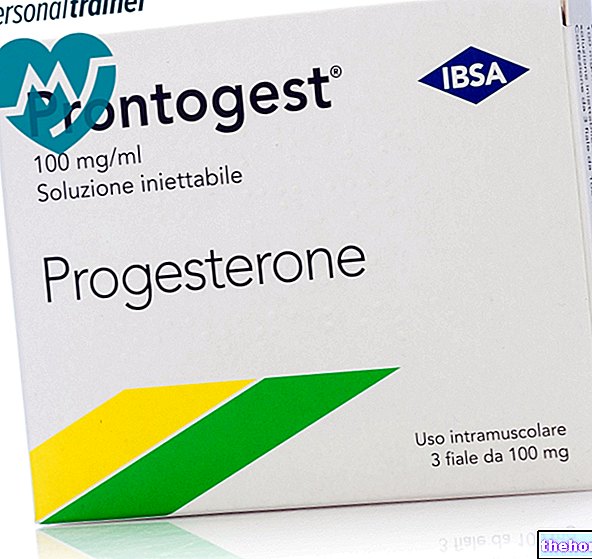Active ingredients: Exenatide
Bydureon 2 mg powder and solvent for prolonged-release suspension for injection
Source Package Leaflet: AIFA (Italian Medicines Agency). Content published in January 2016. The information present may not be up-to-date.
To have access to the most up-to-date version, it is advisable to access the AIFA (Italian Medicines Agency) website. Disclaimer and useful information.
01.0 NAME OF THE MEDICINAL PRODUCT -
BYDUREON 2 MG POWDER AND SOLVENT FOR INJECTABLE SUSPENSION WITH PROLONGED RELEASE
02.0 QUALITATIVE AND QUANTITATIVE COMPOSITION -
Each vial contains 2 mg of exenatide.
For the full list of excipients, see section 6.1.
03.0 PHARMACEUTICAL FORM -
Prolonged-release powder and solvent for suspension for injection.
Powder: White to off-white powder.
Solvent: clear, colorless light yellow to light brown solution.
04.0 CLINICAL INFORMATION -
04.1 Therapeutic indications -
Bydureon is indicated for the treatment of type 2 diabetes mellitus in combination with:
• Metformin
• Sulfonylurea
• Thiazolidinedione
• Metformin and sulfonylurea
• Metformin and thiazolidinedione
in adult patients who have not achieved adequate glycemic control with the maximum tolerated dose of these oral therapies.
04.2 Posology and method of administration -
Dosage
The recommended dose is 2 mg of exenatide once a week.
Patients switching from immediate-release exenatide (Byetta) to prolonged-release exenatide (Bydureon) may experience transient increases in blood glucose concentrations which generally improve within the first two weeks after initiation of therapy.
When prolonged-release exenatide is added to existing metformin and / or a thiazolidinedione therapy, the ongoing dose of metformin and / or thiazolidinedione can be maintained. When prolonged-release exenatide is added to therapy with a sulfonylurea, a reduction in the dose of the sulfonylurea should be considered to reduce the risk of hypoglycaemia (see section 4.4).
Prolonged-release exenatide should be administered once a week, on the same day each week. The day of weekly administration can be changed if necessary as long as the next dose is administered at least one day later (24 hours). Prolonged-release exenatide can be given at any time of the day, regardless of meals.
If a dose is missed, it should be administered as soon as possible. For the next injection, patients can go back to their chosen injection day. However, only one injection should be given within 24 hours.
The use of prolonged-release exenatide does not require additional self-monitoring of blood glucose levels. However, self-monitoring of blood glucose levels may become necessary to adjust the dose of the sulfonylurea.
If a different glucose-lowering treatment is initiated after discontinuation of prolonged-release exenatide, attention should be paid to prolonged-release prolonged-release exenatide (see section 5.2).
Special populations
Senior citizens
No dose adjustments are required based on age. However, as renal function generally decreases with age, the patient's renal function should be considered (see patients with renal impairment). Clinical experience in patients over 75 years is very limited (see section 5.2).
Kidney damage
No dose adjustments are required for patients with mild renal impairment (creatinine clearance 50 to 80 ml / min). Clinical experience in patients with moderate renal impairment (creatinine clearance 30 to 50 ml / min) is very limited (see section 5.2). Prolonged-release exenatide is not recommended in these patients.
Prolonged-release exenatide is not recommended in patients with end-stage renal disease or severe renal impairment (creatinine clearance
Hepatic impairment
No dose adjustments are required for patients with hepatic impairment (see section 5.2).
Pediatric population
The safety and efficacy of prolonged-release exenatide in children and adolescents aged less than 18 years have not yet been established. Currently available data are described in section 5.2, but no recommendation on a posology can be made.
Method of administration
Prolonged-release exenatide is for self-administration by the patient. Each kit is for single person use and is for single use only.
Prior to initiating prolonged-release exenatide treatment, it is strongly recommended that patients and non-healthcare professionals be instructed by a healthcare professional.
The "User Instructions" attached to the package must be followed carefully.
Each dose should be administered by subcutaneous injection into the abdomen, thigh or upper back of the arms immediately after suspension of the powder in the solvent.
For instructions on suspending the medicinal product before administration, see section 6.6 and "Instructions for the user".
04.3 Contraindications -
Hypersensitivity to the active substance or to any of the excipients listed in section 6.1.
04.4 Special warnings and appropriate precautions for use -
Prolonged-release exenatide should not be used in patients with type 1 diabetes mellitus or for the treatment of diabetic ketoacidosis.
Prolonged-release exenatide should not be administered by intravenous or intramuscular injection.
Kidney damage
In patients with end stage renal disease undergoing dialysis, single doses of immediate-release exenatide caused an increase in the frequency and severity of gastrointestinal adverse reactions; therefore, prolonged-release exenatide is not recommended in patients with end stage renal disease or severe renal impairment (creatinine clearance
There have been uncommon cases of renal impairment with exenatide, including increased creatinine, renal impairment, worsening of chronic renal failure and acute renal failure, sometimes requiring hemodialysis. Some of these events occurred in patients who had events capable of altering hydration status, including nausea, vomiting and / or diarrhea and / or who were being treated with medicinal products known to impair hydration / renal function. Medicines taken concomitantly included angiotensin converting enzyme inhibitors, angiotensin II antagonists, non-steroidal anti-inflammatory drugs and diuretics. discontinuation of the agents potentially responsible for these events, including exenatide.
Severe gastrointestinal disease
Prolonged-release exenatide has not been studied in patients with severe gastrointestinal disease, including gastroparesis. Its use is commonly associated with gastrointestinal adverse reactions including nausea, vomiting and diarrhea. Therefore, the use of prolonged-release exenatide is not recommended in patients with severe gastrointestinal disease.
Acute pancreatitis
The use of GLP-1 receptor agonists has been associated with the risk of developing acute pancreatitis. Cases of acute pancreatitis have been reported spontaneously with prolonged-release exenatide. Resolution of pancreatitis has been observed with supportive treatment, but have been reported. very rare cases of necrotizing or haemorrhagic pancreatitis and / or death have been reported. Patients should be informed of the characteristic symptom of acute pancreatitis: severe and persistent abdominal pain. If pancreatitis is suspected, prolonged-release exenatide should be discontinued; if pancreatitis acute is confirmed, prolonged-release exenatide treatment should not be resumed.Caution should be exercised in patients with a history of pancreatitis.
Medicines used at the same time
The use of prolonged-release exenatide in combination with insulin, D-phenylalanine derivatives (meglitinides), alpha-glucosidase inhibitors, dipeptidyl peptidase-4 inhibitors or other GLP-1 receptor agonists has not been studied. The use of prolonged-release exenatide in combination with immediate-release exenatide has not been studied and is not recommended.
Interactions with warfarin
Cases of increased INR (International Normalized Ratio), sometimes associated with bleeding, have been spontaneously reported during concomitant use of warfarin and exenatide (see section 4.5).
Hypoglycemia
When prolonged-release exenatide was used in combination with a sulfonylurea in clinical trials, the risk of hypoglycaemia is increased. In addition, in clinical trials, patients with mild renal impairment receiving treatment in combination with a sulfonylurea had an increased incidence of hypoglycaemia compared to patients with normal renal function. To reduce the risk of hypoglycaemia associated with the use of a sulfonylurea, a reduction in the dose of the sulfonylurea should be considered.
Rapid weight loss
Rapid weight loss> 1.5 kg per week has been observed in patients treated with exenatide. Weight loss of this magnitude can have harmful consequences. Patients with rapid weight loss should be monitored for signs and symptoms of cholelithiasis.
Discontinuation of treatment
After discontinuation, the prolonged-release effect of exenatide may continue as plasma levels of exenatide decrease over 10 weeks. The choice of other medicinal products and the choice of dose should be considered accordingly, as reactions adverse effects may continue and efficacy may persist, at least in part, until exenatide levels decrease.
Excipients
Sodium content: This medicinal product contains less than 1 mmol sodium (23 mg) per dose, ie it is essentially "sodium-free".
04.5 Interactions with other medicinal products and other forms of interaction -
Sulfonylureas
The dose of a sulfonylurea may require adjustment due to the increased risk of hypoglycaemia associated with sulfonylurea therapy (see sections 4.2 and 4.4).
Gastric emptying
The results of a study using paracetamol as a marker of gastric emptying suggest that the effect of prolonged-release exenatide on slowing gastric emptying is minor and is not expected to cause clinically significant reductions in the rate and extent of drug absorption. oral administered simultaneously. Therefore, no dose adjustments are required for medicinal products sensitive to delayed gastric emptying.
When, after 14 weeks of prolonged-release exenatide therapy, 1000 mg paracetamol tablets were administered, without regard to meals, no significant changes in paracetamol AUC were observed compared to the control period. 16% (fasted) and 5% (fed) and the tmax increased from approximately 1 hour in the control period to 1.4 hours (fasted) and 1.3 hours (fed).
The following interaction studies were conducted using immediate-release exenatide 10 mcg but not prolonged-release exenatide:
Warfarin
When warfarin was administered 35 minutes after immediate-release exenatide, a delay in tmax of approximately 2 hours was observed. No clinically significant effects on Cmax or AUC were observed. An increased INR value has been spontaneously reported during concomitant use of warfarin and prolonged-release exenatide. The INR should be checked at initiation of exenatide therapy. prolonged release in patients receiving warfarin and / or coumarin derivatives (see sections 4.4 and 4.8).
Hydroxy methyl glutaryl coenzyme A (HMG CoA) reductase inhibitors
Lovastatin AUC and Cmax were decreased by approximately 40% and 28%, respectively, and tmax was delayed by approximately 4 hours when immediate-release exenatide was administered in combination with a single dose of lovastatin (40 mg ) compared to lovastatin given alone. In 30-week, placebo-controlled clinical trials with immediate-release exenatide, concomitant use of exenatide with HMG CoA reductase inhibitors was not associated with a corresponding change in lipid profile (see paragraph 5.1). No predetermined dose adjustment is required; however, lipid profiles must be monitored appropriately.
Digoxin and lisinopril
In interaction studies of the effect of immediate-release exenatide on digoxin and lisinopril no clinically relevant effects on Cmax or AUC were observed; however, a delay in tmax of approximately 2 hours was observed.
Ethinylestradiol and levonorgestrel
Administration of a combined oral contraceptive (30 micrograms of ethinylestradiol plus 150 micrograms of levonorgestrel) one hour prior to immediate-release exenatide did not change the AUC, Cmax, or Cmin of ethinylestradiol or levonorgestrel. Administration of the combined oral contraceptive 35 minutes after exenatide did not change the AUC, but resulted in a 45% reduction in ethinylestradiol Cmax and a 27-41% reduction in levonorgestrel Cmax and a 2-4 hour delay in tmax due to slower gastric emptying The reduction in Cmax is of limited clinical relevance and no dose adjustment is required for oral contraceptives.
Pediatric population
Interaction studies with exenatide have only been performed in adults.
04.6 Pregnancy and breastfeeding -
Women of childbearing potential
Due to the long elimination period of prolonged-release exenatide, women of childbearing potential must use contraception during treatment with prolonged-release exenatide. Prolonged-release exenatide should be stopped at least 3 months before the planned pregnancy.
Pregnancy
Data from the use of prolonged-release exenatide in pregnant women are not adequate. Studies in animals have shown reproductive toxicity (see section 5.3). The potential risk for humans is unknown. Prolonged-release exenatide it should not be used during pregnancy and the use of insulin is recommended.
Feeding time
It is not known whether exenatide is excreted in human milk. Prolonged-release exenatide should not be used during breastfeeding.
Fertility
No human fertility studies have been performed.
04.7 Effects on ability to drive and use machines -
Prolonged-release exenatide has minor effects on the ability to drive or use machines. When prolonged-release exenatide is used in combination with a sulfonylurea, patients should be advised to take the necessary precautions to avoid the occurrence of a hypoglycaemic reaction while driving a vehicle or using machinery.
04.8 Undesirable effects -
Summary of the safety profile
The most frequent adverse reactions were mainly gastrointestinal (nausea which was the most frequent and associated reaction upon initiation of treatment and decreased with continued therapy, and diarrhea). injection site (itching, nodules, erythema), hypoglycaemia (with a sulfonylurea) and headache. Most adverse reactions associated with the use of prolonged-release exenatide were mild to moderate in intensity.
Since immediate-release exenatide has been marketed, acute pancreatitis has been reported with an unknown frequency and acute renal failure has been reported uncommonly (see section 4.4).
Summary table of adverse reactions
The frequency of prolonged-release adverse reactions identified from clinical trials and spontaneous reports (not observed in clinical trials, frequency not known) are summarized below in Table 1.
The data source of the clinical trials of exenatide includes 18 placebo-controlled clinical trials 21 active controlled and 2 open-label clinical trials. Background therapies included diet and exercise, metformin, a sulfonylurea, a thiazolidinedione, or a combination of oral hypoglycemic drugs.
Reactions are listed below under MedDRA terms based on system organ class and absolute frequency. Frequencies are defined as: very common (≥1 / 10), common (≥1 / 100,
Table 1: Adverse reactions of prolonged-release exenatide identified from clinical studies and spontaneous reports
¹ Incidence based on completed long-term efficacy and safety studies with prolonged-release exenatide total n = 2868 (patients treated with sulfonylurea n = 1002).
² Incidence based on spontaneous reporting data with prolonged-release exenatide (denominator unknown).
Description of selected adverse reactions
Hypoglycemia
The incidence of hypoglycaemia was increased when prolonged-release exenatide was used in combination with a sulfonylurea (24.0% versus 5.4%) (see section 4.4). To reduce the risk of hypoglycaemia associated with the use of a sulfonylurea, dose reduction of the sulfonylurea may be considered (see sections 4.2 and 4.4).
Prolonged-release exenatide was associated with a significantly lower incidence of hypoglycaemic episodes compared to basal insulin in patients also receiving metformin therapy (3% versus 19%) and also in patients receiving sulfonylurea-associated metformin therapy (20% versus 42%).
In the 11 prolonged-release exenatide studies, most episodes (99.9% n = 649) of hypoglycaemia were minor and resolved with oral carbohydrate administration. Only one patient reported a major hypoglycemic episode because he had low blood glucose (2.2 mmol / L) and required assistance with oral carbohydrate treatment that resolved the event.
Nausea
The most frequently reported adverse reaction was nausea. In patients treated with prolonged-release exenatide, generally 20% reported at least one episode of nausea compared with 34% of patients treated with immediate-release exenatide. Most episodes of nausea were mild to moderate. With continued therapy, the frequency decreased in most patients who initially had nausea.
The incidence of discontinuation due to adverse events during the 30-week controlled clinical trial was 6% in prolonged-release exenatide-treated patients, 5% in immediate-release exenatide-treated patients. Common leading to discontinuation of treatment in each treatment group were nausea and vomiting. Discontinuation due to nausea or vomiting was
Injection site reactions
During the 6 months of the controlled phase of the studies, injection site reactions were reported at a higher frequency in patients treated with prolonged-release exenatide than in patients treated with comparator (16% versus the range 2-7%). These injection site reactions were generally mild and did not normally lead to withdrawal from studies. Patients can be treated to relieve symptoms while continuing treatment. A different injection site should be used each week for subsequent injections. In post-marketing experience, cases of abscess and cellulitis at the injection site have been reported.
Small subcutaneous nodules at the injection site have been observed very frequently in clinical studies, consistent with the known properties of poly (D, L-lactide-co-glycolide) polymer bead formulations. Most of the individual nodules were asymptomatic, did not interfere with study participation, and resolved within 4-8 weeks.
Immunogenicity
Consistent with the potential immunogenicity of protein and peptide drugs, patients may develop anti-exenatide antibodies following prolonged-release exenatide treatment. In most patients who develop antibodies, the antibody titer decreases over time.
The presence of antibodies (high or low titer) is not predictive of blood glucose control for an individual patient.
In prolonged-release exenatide clinical trials, approximately 45% of patients had low anti-exenatide antibody titer at the end of the study. The overall percentage of patients with antibody positivity was consistent across all clinical trials. Overall, the level of glycemic control (HbA1c) was comparable to that seen in patients with no antibody response. In phase 3 studies, on average, 12% of patients had a higher antibody titer. In some of these, the glycemic response to prolonged-release exenatide was absent at the end of the controlled period of the studies; 2.6% of patients showed no improvement in blood glucose with higher antibody titers, while 1.6% showed no improvement with antibody negative.
Patients who have developed anti-exenatide antibodies tend to have more reactions at the injection site (for example: redness of the skin and itching), but, on the other hand, experience adverse events of similar incidence and type to patients who do not they developed anti-exenatide antibodies.
For patients treated with prolonged-release exenatide, the incidence of potentially immunogenic reactions at the injection site (most commonly pruritus with or without erythema) during the 30-week study and the two 26-week studies was approximately 9%. These reactions were observed less commonly in antibody negative patients (4%) than in antibody positive patients (13%), with a higher incidence in those with a higher antibody titer.
Examination of antibody-positive samples showed no significant cross-reactivity with similar endogenous peptides (glucagon or GLP-1).
Rapid weight loss
In a 30-week clinical study, approximately 3% of patients (n = 4/148) treated with prolonged-release exenatide experienced at least one time period of rapid weight loss (the loss of body weight detected between 2 consecutive control in the study was greater than 1.5 kg / week).
Increased heart rate
A mean increase in heart rate (HR) of 2.6 beats per minute (bpm) from baseline (74 bpm) was observed in pooled prolonged-release exenatide clinical trials. Fifteen percent of patients treated with prolonged-release exenatide had mean increases in HR of ≥10 bpm; approximately 5% to 10% of subjects within the other treatment groups had mean increases in HR ≥10 bpm.
Reporting of suspected adverse reactions
Reporting of suspected adverse reactions occurring after authorization of the medicinal product is important as it allows continuous monitoring of the benefit / risk balance of the medicinal product. Healthcare professionals are asked to report any suspected adverse reactions via the national reporting system. at the address www.agenziafarmaco.gov.it/it/responsabili.
04.9 Overdose -
Effects of exenatide overdose (based on immediate-release exenatide clinical studies) include severe nausea, severe vomiting and rapid fall in blood glucose. In the event of an overdose, appropriate supportive treatment should be initiated depending on the clinical signs and symptoms experienced by the patient.
05.0 PHARMACOLOGICAL PROPERTIES -
05.1 "Pharmacodynamic properties -
Pharmacotherapeutic group: Medicines used in diabetes, other hypoglycemic agents, excluding insulins.
ATC code: A10BX04.
Mechanism of action
Exenatide is a glucagon-like-peptide-1 (GLP-1) receptor agonist that exhibits numerous antihyperglycemic actions of glucagon-like-peptide-1 (GLP-1). The amino acid sequence of exenatide partially overlaps that of human GLP-1. Exenatide showed in vitro to bind to the human GLP-1 receptor and activate it with a mechanism of action mediated by cyclic AMP and / or other intracellular signaling pathways.
Exenatide increases insulin secretion from pancreatic beta cells in a glucose-dependent manner. As blood sugar drops, insulin secretion slows down. When exenatide was used in combination with metformin and / or thiazolidinedione, no increase in the incidence of hypoglycaemia was observed compared to placebo in combination with metformin and / or thiazolidinedione, this may be due to this glucose-dependent insulinotropic mechanism (see paragraph 4.4).
Exenatide suppresses glucagon secretion which is known to be inappropriately elevated in patients with type 2 diabetes. Lower glucagon concentrations result in decreased hepatic glucose output. However, exenatide does not alter normal glucagon response and other hormonal responses. to hypoglycemia.
Exenatide slows down gastric emptying and consequently reduces the rate at which the glucose introduced with the meal appears in the circulation.
Administration of exenatide has been shown to reduce food intake as a result of decreased appetite and increased satiety.
Pharmacodynamic effects
Exenatide improves glycemic control through its prolonged effects on fasting and postprandial blood glucose lowering in patients with type 2 diabetes. Unlike endogenous GLP-1, prolonged-release exenatide has a pharmacokinetic and pharmacodynamic profile in men appropriate to a administration once a week.
A pharmacodynamic study with exenatide has shown in patients with type 2 diabetes (n = 13) a restoration of the first phase of insulin secretion and an improvement of the second phase of insulin secretion in response to the administration of an intravenous bolus of glucose. .
Clinical efficacy and safety
The results of the long-term clinical trials of prolonged-release exenatide are presented below; these studies involved 1628 subjects (804 treated with prolonged-release exenatide), 54% men and 46% women, 281 subjects (141 treated with prolonged-release exenatide) were aged ≥65 years.
Glycemic control
In two studies, prolonged-release exenatide 2 mg once weekly was compared with immediate-release exenatide 5 mcg twice daily for 4 weeks followed by immediate-release exenatide 10 mcg twice daily. One study lasted 24 weeks (n = 252) and the other study lasted 30 weeks (n = 295) and was followed by an open-label extension phase where all patients were treated with 2 mg prolonged-release exenatide once once per week for an additional 22 weeks (n = 243). In both studies, reductions in HbA1c were evident in both treatment groups as early as the first HbA1c measurement (after 4 or 6 weeks) after the start of treatment.
Prolonged-release exenatide resulted in a statistically significant reduction in HbA1c compared to patients who received immediate-release exenatide (Table 2).
A clinically relevant effect on HbA1c was seen in both prolonged-release and twice-daily exenatide-treated patients in both studies, regardless of background antidiabetic therapy.
More patients treated with prolonged-release exenatide than patients treated with immediate-release exenatide achieved a reduction in HbA1c ≤7% or
Both prolonged-release and immediate-release exenatide-treated patients achieved a reduction in body weight from baseline, although the differences between the two treatment arms were not significant.
Further reductions in HbA1c and sustained weight reduction over time were observed for at least 52 weeks in patients who completed both the 30-week controlled study and the uncontrolled extension study. Evaluable patients who switched from exenatide to release prolonged-release exenatide (n = 121) achieved the same improvement in HbA1c of -2.0% at the end of 22 weeks of extension from baseline as did patients treated with prolonged-release exenatide for 52 weeks.
Table 2: Results from two prolonged-release exenatide studies versus immediate-release exenatide in combination with diet and exercise only, metformin and / or sulfonylurea and metformin and / or thiazolidinedione (intent to treat patient sample)
ES = standard error, CI = confidence interval, * p
A 26-week study was conducted in which 2 mg prolonged-release exenatide was compared with once daily insulin glargine. Prolonged-release exenatide demonstrated greater variation in HbA1c than insulin glargine. Compared to insulin glargine treatment, prolonged-release exenatide treatment significantly reduced mean body weight and was associated with fewer hypoglycemic events (Table 3).
Table 3: Results from a 26-week study of prolonged-release exenatide versus insulin glargine in combination with metformin alone or metformin and sulphonylurea (intent to treat patient sample)
ES = standard error, CI = confidence interval, * p
¹ Insulin glargine was measured at the target glucose concentration of 4.0-5.5 mmol / L (72-100 mg / dL). The mean insulin glargine dose at the start of treatment was 10.1 IU / day with increases up to 31.1 IU / day for patients treated with insulin glargine.
The results at week 156 were consistent with those previously reported in the interim report at week 26. Treatment with prolonged-release exenatide persistently and significantly improved glycemic control and weight control, compared to treatment with insulin glargine. The safety results after 156 weeks were consistent with those reported at 26 weeks.
In a 26-week double-blind study prolonged-release exenatide was compared to maximum daily doses of sitagliptin and pioglitazone in subjects who were also taking metformin. All treatment groups had a significant reduction in HbA1 from baseline. Prolonged-release exenatide demonstrated superiority in terms of change in HbA1c from baseline over both sitagliptin and pioglitazone.
Prolonged-release exenatide demonstrated significantly greater body weight reduction than sitagliptin. Patients treated with pioglitazone had an increase in body weight (Table 4).
Table 4: Results from a 26-week study of prolonged-release exenatide versus sitagliptin e versus pioglitazone in combination with metformin (intent to treat patient sample)
ES = standard error, CI = confidence interval, * p
Body weight
A reduction in body weight from baseline was observed in all prolonged-release exenatide studies. This reduction in body weight was observed in prolonged-release exenatide-treated patients regardless of whether nausea occurred although the reduction was greater in the nausea group (mean reduction from -2.9 kg to -5.2 kg). kg in the presence of nausea compared to an average reduction from -2.2 kg to -2.9 kg with no nausea).
The proportion of patients who had both a reduction in body weight and HbA1c ranged from 70 to 79% (the proportion of patients who had a reduction in HbA1c ranged from 88% to 96%).
Plasma / serum blood glucose
Prolonged-release exenatide treatment resulted in significant reductions in fasting plasma / serum glucose, these reductions were observed as early as 4 weeks. Further reductions were observed in postprandial concentrations. The improvement in fasting plasma / serum glucose was maintained for 52 weeks.
Beta-cell function
Clinical studies with prolonged-release exenatide have indicated improvement in beta-cell function, using measurement methods such as "homeostasis model assessment" (HOMA-B). The duration of effect on beta-cell function was maintained for 52 weeks.
Blood pressure
A reduction in systolic blood pressure (from 2.9 mmHg to 4.7 mmHg) was observed in prolonged-release exenatide studies. In a comparison study with immediate-release exenatide at 30 weeks, both prolonged-release and immediate-release exenatide significantly reduced systolic blood pressure from baseline (4.7 ± 1.1 mmHg and 3.4 ± 1.1 mmHg respectively) and the difference between treatments was not significant. The improvement in blood pressure was maintained for 52 weeks.
Fasting lipids
Prolonged-release exenatide showed no adverse effects on lipid parameters.
Pediatric population
The European Medicines Agency has deferred the obligation to submit the results of studies with prolonged-release exenatide in one or more subsets of the pediatric population with type 2 diabetes mellitus (see section 4.2 for information on pediatric use. ).
05.2 "Pharmacokinetic properties -
The absorption characteristics of exenatide reflect the sustained-release characteristics of the prolonged-release formulation of exenatide. Once absorbed into the circulation, exenatide is distributed and eliminated according to known systemic pharmacokinetic properties (as described in this section).
Absorption
Following weekly administration of 2 mg prolonged-release exenatide, mean exenatide concentrations exceeded trough effective concentrations (~ 50 pg / mL) in 2 weeks with a gradual increase in mean plasma exenatide concentration over 6-7 weeks. Exenatide concentrations of approximately 300 pg / mL were maintained indicating that steady-state has been achieved. Steady-state concentrations of exenatide are maintained over the one week time interval between doses with minimal fluctuation (of peaks and troughs) from this mean therapeutic concentration.
Distribution
The mean apparent volume of distribution of exenatide following subcutaneous administration of a single dose of exenatide is 28 L.
Biotransformation and elimination
Non-clinical studies have shown that exenatide is eliminated primarily by glomerular filtration with subsequent proteolytic degradation. The mean apparent clearance of exenatide is 9 l / h. These pharmacokinetic characteristics of exenatide are independent of the dose. Approximately 10 weeks after discontinuation of prolonged-release exenatide therapy, plasma concentrations of exenatide fell below the minimum detectable concentrations.
Special populations
Kidney damage
Population pharmacokinetic analysis of patients with renal impairment who received 2 mg prolonged-release exenatide indicates that there may be an increase in systemic exposure of approximately 74% and 23% (median prediction in each group), respectively. in patients with moderate (N = 10) and mild (N = 56) renal impairment compared to patients with normal renal function (N = 84).
Hepatic insufficiency
Pharmacokinetic studies have not been conducted in patients with hepatic impairment. Exenatide is eliminated primarily via the kidney; therefore, hepatic dysfunction is not expected to alter plasma concentrations of exenatide.
Gender, race and body weight
Gender, race and body weight have no clinically relevant influence on the pharmacokinetic properties of exenatide.
Senior citizens
Data in elderly patients are limited, but do not suggest any marked changes in exenatide exposure with increasing age up to approximately 75 years.
In an immediate-release exenatide pharmacokinetic study in patients with type 2 diabetes, administration of exenatide (10 micrograms) resulted in a mean increase in exenatide AUC of 36% in 15 elderly subjects aged 75 to 85. years compared to 15 subjects aged between 45 and 65 years probably related to reduced renal function in the older age group (see section 4.2).
Pediatric population
In a pharmacokinetic study with immediate-release exenatide in 13 patients with type 2 diabetes aged 12 to 16 years, administration of exenatide (5 micrograms) as a single dose resulted in slightly lower mean AUC values (16 % lower) and Cmax (25% lower) than those seen in adult patients No pharmacokinetic studies with prolonged-release exenatide have been conducted in the pediatric population.
05.3 Preclinical safety data -
Non-clinical data reveal no special hazard for humans based on conventional studies of safety pharmacology, repeated dose toxicity or genotoxicity conducted with immediate-release or prolonged-release exenatide.
In a 104-week carcinogenicity study with prolonged-release exenatide, a statistically significant increase in the incidence of thyroid C-cell tumors (adenoma and / or carcinoma) was observed in rats at all doses (1.4 to 26 times the clinical exposure in humans with prolonged-release exenatide). The relevance of these findings to humans is currently unknown.
Animal studies with exenatide did not indicate direct harmful effects on fertility; high doses of exenatide caused skeletal effects and reduced fetal and neonatal development.
06.0 PHARMACEUTICAL INFORMATION -
06.1 Excipients -
Dust
poly (D, L-lactide-co-glycolide);
sucrose.
Solvent
croscarmellose sodium;
sodium chloride;
polysorbate 20;
sodium dihydrogen phosphate monohydrate;
disodium phosphate heptahydrate;
water for injections.
06.2 Incompatibility "-
In the absence of compatibility studies, this medicinal product must not be mixed with other medicinal products.
06.3 Period of validity "-
3 years.
After the suspension
The suspension should be injected immediately after mixing the powder and solvent.
06.4 Special precautions for storage -
Store in a refrigerator (2 ° C - 8 ° C).
Do not freeze.
Before use, the kit can be kept for up to 4 weeks at a temperature below 30 ° C.
Store in the original package to protect the medicine from light.
For storage conditions after mixing the medicinal product, see section 6.3.
06.5 Nature of the immediate packaging and contents of the package -
The powder is packaged in a 3 ml Type I glass vial closed with a chlorobutyl rubber disc and an aluminum seal with a flip-off plastic cap.
The solvent is packaged in a 1.5 ml Type I glass pre-filled syringe closed with a bromobutyl rubber cap and a rubber plunger.
Each single-dose kit contains one vial with 2 mg of exenatide, one pre-filled syringe with 0.65 ml of solvent, one vial connector and two injection needles (one spare).
Pack of 4 single-dose kits and a multipack containing 12 single-dose kits (3 packs x 4). Not all pack sizes may be marketed.
06.6 Instructions for use and handling -
The patient should be advised to discard the needle safely, with the needle still inserted after each injection. The patient does not need to keep any components of the disposable kit.
The solvent should be visually inspected before use. The solvent should only be used if it is clear and free of particles. After suspension, the mixture should only be used if it appears white to off-white and cloudy.
Prolonged-release exenatide should be injected immediately after suspension of the powder in the solvent.
Prolonged-release exenatide should not be used if it has been frozen.
Unused medicine and waste derived from this medicine must be disposed of in accordance with local regulations.
07.0 HOLDER OF THE "MARKETING AUTHORIZATION" -
AstraZeneca AB
SE-151 85 Södertälje
Sweden
08.0 MARKETING AUTHORIZATION NUMBER -
EU / 1/11/696 / 001-002
041276015
041276027
09.0 DATE OF FIRST AUTHORIZATION OR RENEWAL OF THE AUTHORIZATION -
Date of first authorization: 17 June 2011
Date of most recent renewal: June 17, 2016
10.0 DATE OF REVISION OF THE TEXT -
February 2016




























